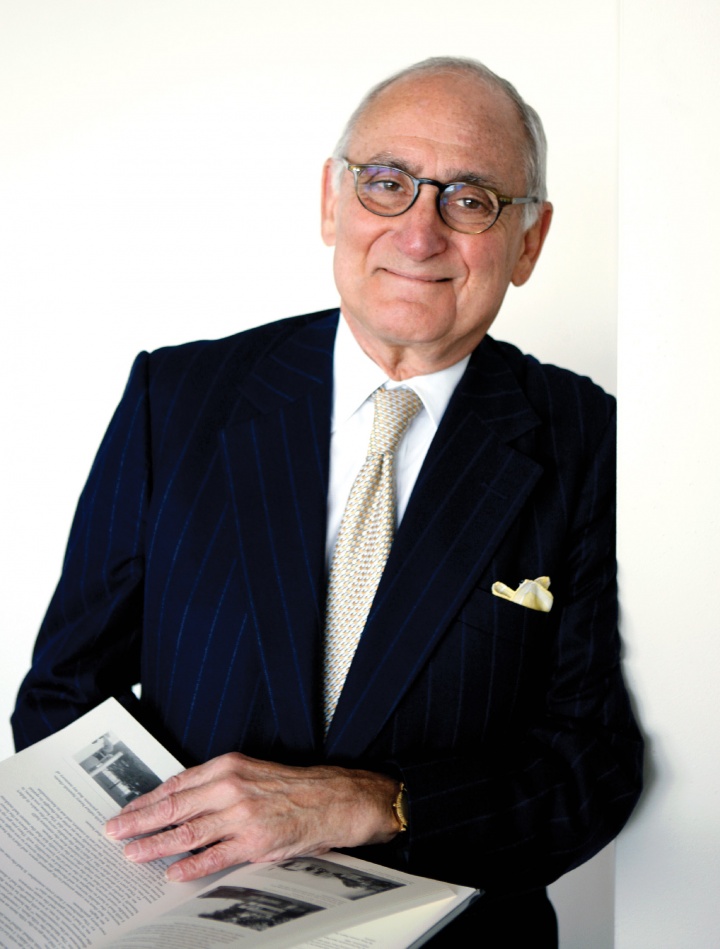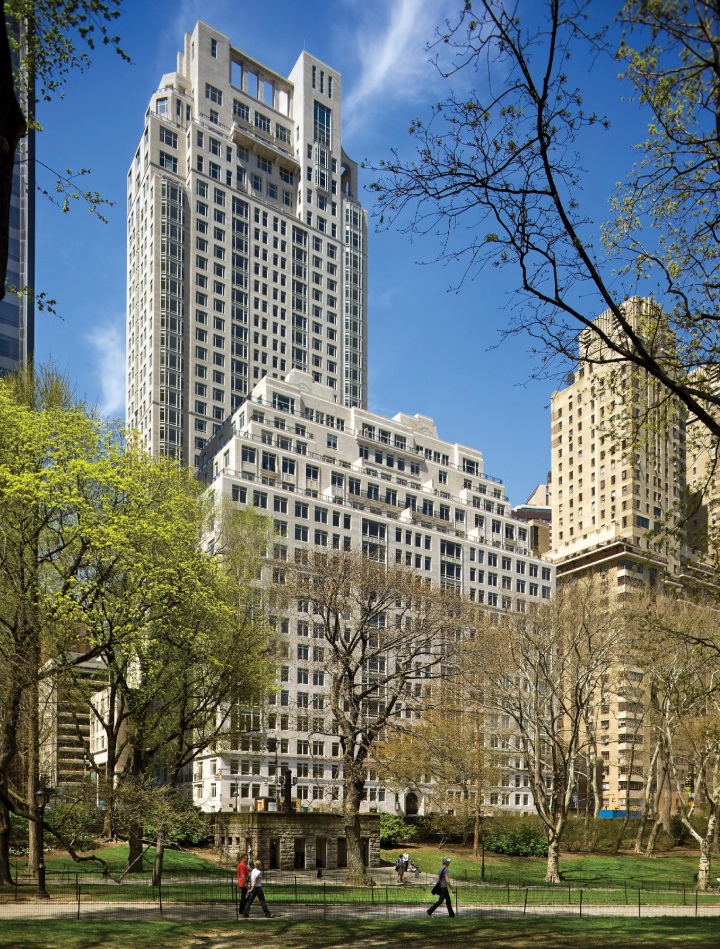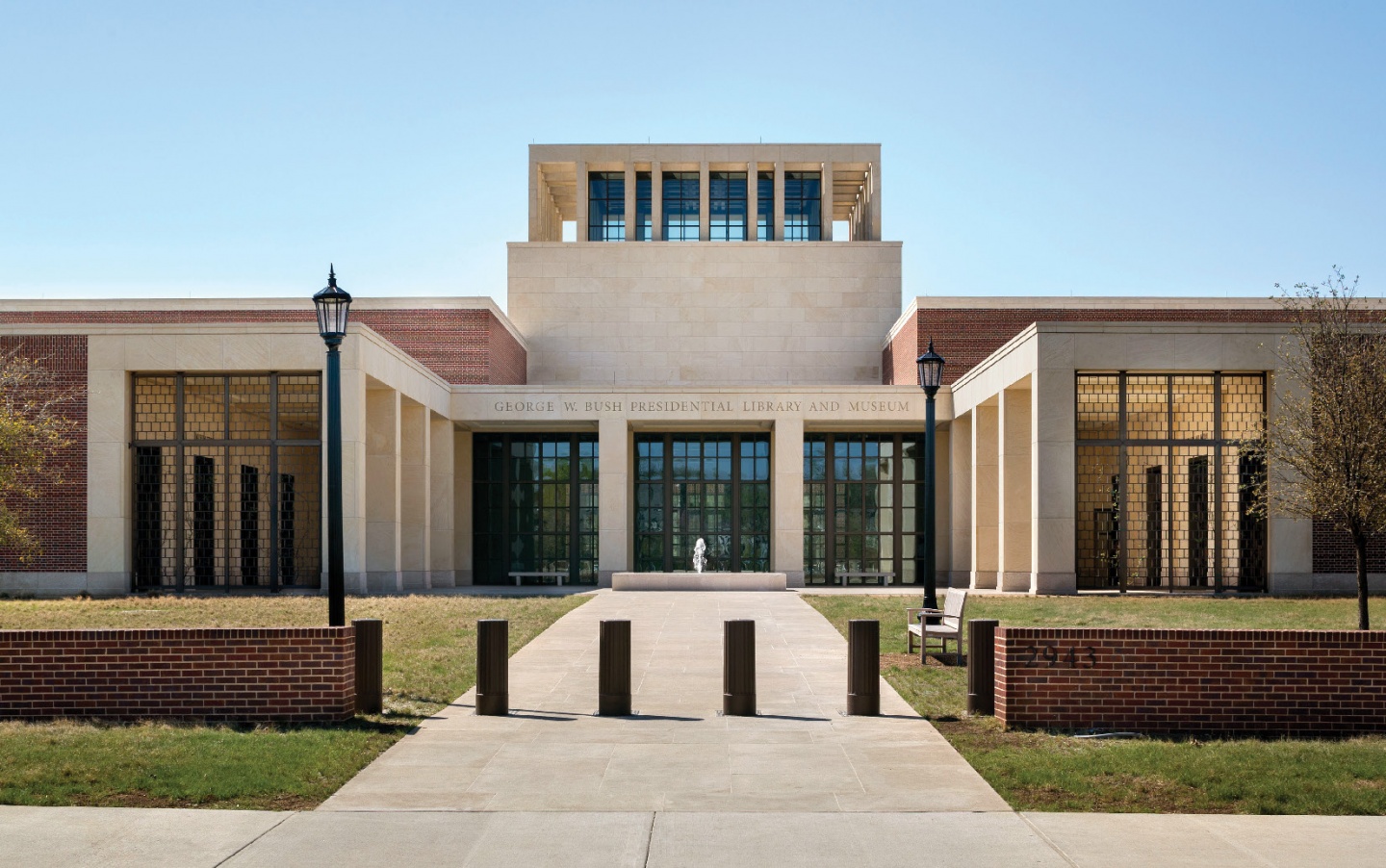Architect Robert A.M. Stern ’60 designs everything from skyscrapers to country homes with both the past and the future in mind.
Columbia College | Columbia University in the City of New York
Architect Robert A.M. Stern ’60 designs everything from skyscrapers to country homes with both the past and the future in mind.

Courtesy Robert A.M. Stern Architects
At both Columbia and Yale, where Robert A.M. Stern ’60 has spent his long and distinguished academic career, the Roman goddess Minerva is a reigning presence — if not as a deity, then certainly as statuary. On the Morningside campus, where Stern taught for 28 years, Daniel Chester French’s iconic Alma Mater surveys her neoclassical domain from the heights of Low Plaza; though her identity is open to interpretation, the little owl discreetly tucked into her bronze cloak is a surefire emblem of the goddess of wisdom and knowledge. At the Yale School of Architecture, where Stern earned an M.Arch. in 1965 and was dean from 1998 until this past July, a statue of Minerva towers over the main studio of the school’s Paul Rudolph–designed building, a landmark of Brutalist architecture. The sensitively executed renovation, restoration and expansion of Rudolph Hall, which had been degraded by a 1969 fire and later modifications, was a signature accomplishment of Stern’s deanship. “Minerva presides over us all and keeps us honest and true,” a twinkly-eyed Stern proclaims in a 2009 documentary film about the $126 million project.
Stern recalls spending long hours in that studio with fellow architecture students in the early 1960s, drafting projects and assignments.
“In those days, the phone would ring, and we would let it ring and ring and ring — nobody ever wanted to answer it,” he says. “But eventually somebody would get so sick of the sound of it that they would pick up. And whoever it was might call out, ‘Bob Stern — your mother’s on the phone.’ That was the worst humiliation known to man.”
One time, however, it wasn’t his mother. “Someone announced, ‘Bob Stern — Philip Johnson is on the phone.’ Everybody put their pencils down. ‘What does Philip Johnson want with Bob Stern?’”

15 Central Park West
New York City
Peter Aaron / Otto
At the time, Johnson was a preeminent figure in American architecture. An early champion of the modernist International Style, he was also an influential curator, critic and historian. Then lecturing at Yale (and designing the university’s new biology tower), Johnson recognized Stern’s potential and took him under his wing. Johnson became one of Stern’s two prime mentors in New Haven, along with renowned architectural historian Vincent Scully.
When Johnson called the studio that day in 1965, it was to persuade his protégé to accept a position as program director at The Architectural League of New York.
“Don’t you think I ought to get a job with an architect?” Stern asked him.
“Oh, what do you want to do that for?” Johnson said. “I never did that.”
Stern took the post, which came with a fellowship, and spent the next year organizing biweekly exhibits of cutting-edge architects like Robert Venturi and Romaldo Giurgola, culminating in a groundbreaking exhibition of young talent, including Stern himself. “Of course you should put your own work in the show,” Johnson had insisted. “What’s the point of doing it if not that?”
“So that’s how I got up my courage for my first act of immodesty,” Stern later told George Dodds of the Journal of Architectural Education — that is, he added, “my first recorded act of immodesty.”

Broadway Residence Hall
West 114th Street and Broadway
New York City
Peter Aaron/Otto
Looking back over the fullness of his career, there is little for Stern to be modest about. He has made an indelible mark as a practitioner, teacher, scholar and writer — a rare breadth of accomplishment, marked by personal flair. “A house by Stern is never that stern,” a fellow architect once said. “It is something like his personality — impish, mercurial and above all, witty.”
Led by the debonair Stern — known for his chalk-striped bespoke suits, buttery-yellow pocket squares and suede Gucci loafers — Robert A.M. Stern Architects (widely known as RAMSA) has assembled a distinctive and varied portfolio on four continents: soaring urban structures and exquisite country homes; major museums and libraries; courthouses; hotels; chapels; performing arts centers; planned communities; and dozens of academic buildings — at Wake Forest, Stanford, UVA, Johns Hopkins, Notre Dame, Colorado, Georgetown and many other campuses, including every Ivy school save Cornell. One of his earliest commissions was the 1977 renovation of Columbia’s Women’s Faculty Club (now Jerome Greene Annex); in 2000, Columbia opened the RAMSA-designed Broadway Hall on West 113th Street, adding welcome dormitory space.
In recent years, RAMSA has completed a host of notable works, including the Comcast Center, Philadelphia’s tallest building, and Stern’s landmark residential tower at 15 Central Park West in Manhattan. Inspired by the grand pre-war apartment buildings flanking the park, it was a spectacular success for its developers, especially after celebs such as Sting and Denzel Washington bought in. A typical three-bedroom, 2,846-sq. ft. apartment recently sold for $28 million. The price of a penthouse could put a dent in the GDP of Macedonia.
A lucid and meticulous writer on architecture, Stern has authored or co-authored nearly two dozen books, including his monumental five-volume study of New York City architecture since 1880; the middle volume, New York 1930: Architecture and Urbanism Between the Two World Wars (written with Thomas Mellins ’79 and Gregory Gilmartin ’81) was nominated in 1987 for the National Book Award in nonfiction. Another tome, Pride of Place: Building the American Dream, was the companion volume to the eight-part PBS television series he hosted in 1986.
By all accounts a demanding teacher and hands-on participant in all of RAMSA’s projects, Stern has guided a legion of architects into the profession; a number came out of the undergraduate architecture program he established at the College in the early 1970s, including RAMSA partners Paul Whalen ’78, Randy Correll ’80, GSAPP’83 and Preston Gumberich ’84, GSAPP’87. Along with so many others who studied with Stern when he taught at the graduate level, they encountered his deep appreciation of architectural traditions.
Respect for the old is not enough,however.“Traditional architecture is convincing when it comes out of a passionate feeling for the craft and art of architecture — for what it means and where it is appropriate,” Stern has observed. “We cannot deny the sincerity of Santa Barbara’s Spanish colonial architecture; but when it appears on the highway strip as a Taco Bell, that is a very different story. In short, quality is every bit as important as context.”
“Stern’s whole view of architecture is one of continuity,”says Pulitzer Prize-winning architecture critic Paul Goldberger. “He doesn’t believe that architecture needs to keep reinventing itself. For him the priority is preserving the knowledge acquired over centuries and passing the baton to succeeding generations through his teaching and writing. He is a great mentor to younger practitioners.”

Courtesy Robert A.M. Stern Architects
Robert Arthur Morton Stern grew up modestly in Brooklyn’s Kensington/Windsor Terrace neighborhood, the older son of Sidney Stern, who worked various jobs — selling insurance, running a hardware store, driving a cab — and his wife, Sonya, who sold china at B. Altman & Co.’s department store; both are now deceased. Stern’s brother, Elliot ’70, became a scholar in Sanskrit and Indian philosophy, and has worked for the IRS.
Stern tinkered with an Erector Set as a boy, and his father took him to marvel at the American Flyer model railroad displays at the Gilbert Hall of Science on Fifth Avenue. Stern enjoyed playing the piano and biked around Prospect Park to the Brooklyn Public Library to borrow sheet music for popular songs from the ’30s, a passion that has endured.
At Manual Training H.S. in Park Slope, the teachers were very good, he says (“not a bad apple in the bunch”). Stern especially took to Latin, drama, geometry and trigonometry, and showed a precocious interest in The New York Times Real Estate section, especially views and plans of the homes and developments then mushrooming in the suburbs. “I would redraw the plans,” he says, “because I always knew I could do better.” Stern’s skills were soon refined enough to earn third prize in a Pratt Institute competition in which students were given five hours to design a house within certain guidelines. “I had had no training or anything,” he says. “I was thrilled beyond all measure.”
According to the cliché, a Columbia College freshman in 1956 was probably a Harvard reject. In Stern’s case, the cliché was true. “And I was pissed,” he says. What’s more, he had to commute from Brooklyn until a room opened up in Livingston (now Wallach) Hall, and there was no undergraduate architecture program. Nonetheless, he warmed to the College, especially the Core courses (“which I still admire and defend,” he says) and freshman English. “I loved my instructor, Jeffrey Hart ’52, GSAS’61, who became one of the great conservative curmudgeons,” Stern says. “He taught me how to write in a reasonably good way.”
Stern majored in history — Professor James Shenton ’49, GSAS’54, was a favorite — and took English courses with Mark Van Doren GSAS’21, Lionel Trilling ’25, GSAS’38 and other leading lights. “I got to like Columbia a lot better because of the quality of the education,” he says, “and I made some good friends.” Among them were Korean War vet Stephen Baldwin ’59; attorney Sam Wiseman ’60, LAW’63, whose Montauk home was one of the architect’s earliest commissions; and Doug Morris ’60, the legendary music mogul, who tore Stern away from his Sinatra records to listen to “Itsy Bitsy Teenie Weenie Yellow Polka Dot Bikini.”

Comcast Center
Philadelphia
Peter Aaron / Otto
Three other Columbia figures helped Stern advance toward his life’s work, he says: architectural historian Robert Branner (“who brought a fresh, interpretive approach to the field”); Everard Upjohn, great-grandson of the architect of Trinity Church, who taught “Elements of Architecture,” teaching students “to take apart buildings and think about how they go together, like a great grammarian might do with sentence structure in the old days”; and Adolf Placzek LS’42, longtime librarian at Columbia’s Avery Architectural & Fine Arts Library.
Stern applied to five grad schools — Columbia, Michigan, Penn, Harvard and Yale — and was accepted by all. He chose Yale, he says, because it felt like something important was brewing there with its young architecture dean, Rudolph, and his plans for a striking new building.
After his graduate studies and the year at The Architectural League of New York, Stern worked for the firm of Richard Meier, then worked in the NYC Housing Preservation & Development administration under Mayor John V. Lindsay. In 1966 he married Lynn Solinger, a Smith graduate whose father was president of the Whitney Museum and whose mother belonged to the Gimbel family, of department store fame — valuable connections for a young unknown. (Divorced in 1977, they have one son, Nicholas S.G. Stern ’90, who runs a boutique construction firm in New York, and three grandchildren.) In 1969, Stern opened his own practice with fellow Yalie John S. Hagmann, which lasted until 1977, when RAMSA was formed.
“Traditional architecture is convincing when it comes out of a passionate feeling for the craft and art of architecture — for what it means and where it is appropriate.”
Stern joined the faculty of the Graduate School of Architecture, Planning and Preservation (GSAPP) in 1970. Named full professor in 1982, he played an important role in the school’s revitalization as a toptier institution during the widely admired deanship of James Stewart Polshek. Stern directed Columbia’s Historic Preservation Program and was the founding director of The Temple Hoyne Buell Center for the Study of American Architecture.
Keenly aware that the College’s lack of studio architecture courses placed career-minded undergraduates at a disadvantage, Stern worked with then-Associate Dean of the College Michael Rosenthal GSAS’67 to develop a major. “It became an incredibly intense, effective program,” Rosenthal says. “Once you registered for his studio, that was the bulk of your life. Students loved it, though.”
“He was amazingly engaged and proactive,” says architect, author and filmmaker James Sanders ’76, GSAPP’82, who studied under Stern at both the College and GSAPP. “He was also famously tough, and could be quite harsh on work that he didn’t feel was meeting the standard of the school or his class.” Stern insisted that students master traditional skills like drawing and lettering. “You learned how to twirl your pencil as you ran it along your T-square,” Sanders says. “The line couldn’t get thinner or thicker; it had to remain uniform. He wanted his students to come out of Columbia, and his design studio in particular, with incredible presentation skills.”
Though computer renderings have become ubiquitous, Stern continues to champion the importance of hand drawing, something he says he came down on very hard as dean at Yale. “I believe that what you draw, and what you see, and what your brain tells you back and forth, are really where the creative act comes,” he says. “A little potent sketch is much more powerful than any other means of communicating an architectural idea.”

Offices for GlaxoSmithKline
5 Crescent Drive
Philadelphia
In the 1990s, Stern formed an association with the Walt Disney Co., designing projects and holding a seat on the corporate board of directors. He co-developed the master plan for Celebration, Fla., the New Urbanist community near Orlando, and also designed the Yacht Club Resort in Orlando, Fla., and the Feature Animation Studios in Burbank, Calif., whose cone-shaped tower conjures Mickey Mouse’s Sorcerer’s Apprentice cap in Fantasia.
Playful allusions were intrinsic to the Postmodern style Stern embraced in the 1970s and ’80s along with Johnson and others — the “Chippendale” roof line of Johnson’s AT&T Building (now the Sony Tower) on Madison Avenue is a famous example — in reaction to the impersonal, uniformly flat-roofed office buildings Stern describes as “a completely unending string of banalities.” But Stern and his RAMSA colleagues now speak of Postmodernism in the past tense. He calls himself a modern traditionalist. “I don’t believe in architecture as an ideological undertaking,” he says. “I believe it’s an artistic undertaking.”

Yacht Club Resort
Orlando, Fla.
Peter Aaron / Otto
The expectation that one must adhere to a certain style or ideology of architecture especially bothers Stern as an educator.
“I’ve banged away, chipped away at the monolithic approach that plagues academia for sure and the profession considerably, believing that a certain strain of modernism, a response to modernity, was as universal and correct for all situations as the presumed universality and correctness of the Gothic was for the medieval world,” he says. “I think that has been a very important contribution of mine, to open people’s eyes to the complexities and richness of architectural expression, to the fact that architecture has many languages, from high languages of classicism, specific regional languages at a high level, French Renaissance or whatever, to other more vernacular languages. And architects should not only recognize those languages, which they grudgingly do as a group, but learn to speak them and become conversant in them. Architecture is not an autobiographical art. Many architects seem to think that every building they do has to look like their building, which can be a trap.”
“A little potent sketch is much more powerful than any other means of communicating an architectural idea.”

Halkin Mason Photography
Stern has been making this argument for a long time, and he has his detractors. His commercial success, Disney connection and unashamed embrace of traditional styles have made him culturally suspect in certain quarters. Some of the criticism arises from sincere aesthetic and philosophic differences, some from snobbery and some simply ignores the reality that Stern is not so easily pigeonholed — his work is too eclectic, as demonstrated by such ultra-modern designs as The Hobby Center for the Performing Arts in Houston, the Tour Carpe Diem skyscraper near Paris or GlaxoSmithKline’s stunning, double LEED Platinum headquarters in Philadelphia. Nor does he appear to care much about pleasing the purists, in architecture, or for that matter, in politics.
When RAMSA was under consideration to design the George W. Bush Presidential Library and Museum at Southern Methodist University in Dallas, Stern received a note from a Columbia colleague who despised Bush’s politics, saying, “Don’t do it.” Stern replied: “He’s the President of the United States and this is a public institution. And it gives everyone an opportunity to examine — especially when his papers are revealed according to the law — what he did and didn’t do, and whether he did it right or not. So I don’t see this as a political act.”
At the same time, a member of the library project’s selection committee raised the matter of politics from the other side, Stern later learned.
“Well, is he a Republican?” the committeeman demanded to know of Stern.
“Republican enough,” said a well-known businessman who was present.
RAMSA got the nod.
“I am a conservative person,” Stern allows, “but the truth of the matter is, I’m a registered Democrat. But when I vote, I vote as I think. I would describe myself, historically speaking, as a Rockefeller Republican.” He adds ruefully, “I’m the last one living.”

30 Park Place
New York City
Courtesy Robert A.M. Stern Architects
Stern’s appointment at Yale in 1998 was greeted with some skepticism, and he acknowledges he was not the school’s first choice. Reed Kroloff, editor of Architecture magazine at the time, derided him as the “suede-loafered sultan of suburban retrotecture, Disney party boy and notorious academic curmudgeon.” Nine years later, Kroloff took it back, saying, “Bob Stern may be the best school of architecture dean in the United States.”
“The fear was that as dean, he would turn the school into a bastion of traditionalism like Notre Dame,” says architecture critic Goldberger. “In fact, he did the opposite. He welcomed outstanding architects with radically different approaches from his own, like Zaha Hadid and Frank Gehry. He not only maintained Yale’s tradition of pluralism, he brought it to a higher level.” In addition, Goldberger says, “He made certain the school was imparting the highest standards, not only in design, but also in urban planning, historic preservation and building technology.”
“His accomplishment at Yale has been absolutely stellar,” agrees Swiss architect Bernard Tschumi, GSAPP dean from 1988 to 2003. “I think he has put Yale back where it deserves to be, as one of the three best schools in the country. This he did with an enormous amount of flair and intelligence, and it has been good for everybody who is interested in education.”
Tschumi especially appreciates Stern’s zest for the collision of ideas — and his sense of humor, a view echoed by Stern’s successor in the Yale dean’s office, Deborah Berke. “Bob’s a funny guy, and he can make fun of himself,” says Berke. “He loves discussion, he loves the exchange of ideas. He believes — and I think he’s absolutely right in this — that a university is an environment where people can have different points of view and still be friends and colleagues.”
Stern has won numerous honors, including The Richard H. Driehaus Prize in 2011 and the National Building Museum’s Vincent Scully Prize in 2008, and was presented a John Jay Award for distinguished professional achievement by the College in 1991. He has chaired the international jury at the Venice Biennale in 2012 and his works are in the permanent collections of MoMA, the Centre Pompidou and the Art Institute of Chicago, among others. Yet he shows no sign of coasting.

George W. Bush Presidential Library and Museum
Southern Methodist University
Dallas
Peter Aaron / Otto
After a sabbatical Stern will resume teaching at Yale. He’s publishing a book later this year on RAMSA’s recent campus architecture and working on a sixth volume of the New York book series with co-authors David Fishman and Jacob Tilove.
Three of Stern’s skyscrapers are under construction in Manhattan, piercing the skyline that inspired him as a boy in Brooklyn: an 82-story hotel and apartment complex at 30 Park Place; an apartment tower at 520 Park Ave.; and another residential spire, 220 Central Park South, which will be among the city’s tallest structures. All three are clad in limestone, like the Empire State building, and feature the kinds of setbacks and rooftops associated with classic Manhattan tall buildings.
Stern says he’s especially excited about the design of 30 Park Place, which shares a block with the landmark Woolworth Building — once the world’s tallest, now dwarfed by Stern’s — and stares down at the site of the original King’s College and Columbia campus.
“Architecture is not an autobiographical act. Many architects seem to think that every building they do has to look like their building, which can be a trap.”
Always the teacher, always cognizant of history, Stern explains, “It’s my homage to One Wall Street, the Irving Trust Building, which is one of the great buildings of the late ’20s, and one of the great buildings of New York skyscraper history.” He nods and smiles. “It’s a beautiful silhouette.”
Former CCT Editor Jamie Katz ’72, BUS’80 is a freelance author and editor who lives in Upper Manhattan. His last piece for CCT was a profile of Los Angeles mayor Eric Garcetti ’92, SIPA’93.

Published three times a year by Columbia College for alumni, students, faculty, parents and friends.
Columbia Alumni Center
622 W. 113th St., MC 4530, 6th Fl.
New York, NY 10025
212-851-7852
cct@columbia.edu

Columbia Alumni Center
622 W. 113th St., MC 4530, 4th Fl.
New York, NY 10025
212-851-7488
ccalumni@columbia.edu